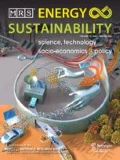Abstract
In the rural areas of the eastern Amhara region where livelihoods are predominantly based on agriculture with almost all the rural people earning their income from agriculture, awareness toward clean energy, and efficient appliances is at a very infant stage. As an indication, the research comes up with energy utilization is mainly of biomass-based with traditional stoves of very low efficiency. However, the future demand of the community toward the clean and improved efficient appliances has got a better preference over other energy technologies. Regarding the factor in determining the energy and energy appliance type choice, accessibility is found as the major reason.}The type of energy sources and energy technologies utilized for cooking and lighting have their own effect on health, environmental degradation, and overall economic development. Therefore, the primary objective of this study was to analyze the general trend of household energy source and energy technology utilization in rural areas of the Eastern Amhara region. The study utilized primary and secondary data collected over stratified systematically sampled households and from energy experts in the area. The study examined the utilization of various forms of energy and energy technology for the most common household energy-intensive processes (injera baking and stew cooking) as well as lighting. The development of different estimates across the whole population of the study region to indicate the relations among different factors was done through different statistical approaches; and the finding of the analysis revealed that 57.7% of the energy share is biomass-based firewood from which 99.5% of this source was used only for food preparation. The two main determinant factors of the community in selecting the energy types are found to be accessibility and health impact.








Similar content being viewed by others
References
Ethiopian Electric Power: https://www.eep.com.et/en/ (accessed 4 May 2017).
Knoema: World Data Atlas-Energy: Ethiopia - Total primary energy consumption: Available at: https://knoema.com/atlas/Ethiopia/Primary-energy-consumption (accessed 1 October 2020).
Ethiopia Energy Situation (2014): Available at: https://energypedia.info/wiki/Ethiopia_Energy_Situation#Energy_Situation/ (accessed May 10, 2020).
Gwavuya S.G., Abele S., Barfuss I., Zeller M., and Müller J.: Household energy economics in rural Ethiopia: A cost-benefit analysis of biogas energy. Renew. Energy 48, 202–209 (2012).
Adkins E., Oppelstrup K., and Modi V.: Rural household energy consumption in the millennium villages in sub-Saharan Africa. Energy Sustain. Dev. 16, 249–259 (2012).
Hassen E.: Key energy issues in Ethiopia: Challenges, opportunities and the way forward. In Agrofuel Development in Ethiopia: Rhetoric, Reality and Recommendations, Tibebwa H. and Negusu A., eds. (Forum for Environment, Addis Ababa, 2008); pp. 1–25.
Getie M. and Degefa M.: Assessment of trend and determinant factors for household energy utilization choice in urban areas of Ethiopia: Case of eastern Amhara. J. Energy Manage. Technol. 4, 67–74 (2020).
Amare D., Endeblhatu A., and Muhabaw A.: Enhancing biomass energy efficiency in rural households of Ethiopia. Energy Nat. Resour. 4, 27–33 (2015).
Hosonuma N., Herold M., De Sy V., De Fries R.S., Brockhaus M., Verchot L., Angelsen A., and Romijn E.: An assessment of deforestation and forest degradation drivers in developing countries. Environ. Res. Lett. 7, 4 (2012).
Mongabay: Deforestation Statistics for Ethiopia: https://rainforests.mongabay.com/deforestation/archive/Ethiopia.htm (accessed 27 August 2020).
Pablo-Romero M.P., Bouznit M., and Sánchez-Braza A.: Residential electricity consumption and economic growth in Algeria. Energies 11, 1656 (2018).
International Energy Agency: www.iea.org (accessed August 26, 2017).
Alem Y., Beyene A., Kohlin G., and Mekonnen A.: Household fuel choice in urban Ethiopia: A random effects multinomial logit analysis. Environment for Development Discussion Paper Series.13, 1–31 (2013).
Terefe Tucho G., Weesie P.D.M., and Nonhebel S.: Assessment of renewable energy resources potential for large scale and standalone applications in Ethiopia. Renew. Sustain. Energy Rev. 40, 422–431 (2014).
Lusambo L.P.: Household energy consumption patterns in Tanzania. J. Ecosyst. Ecography 7, 1–20 (2016).
Hysen B., Sander K., and Haider S.W: Wood-based biomass energy development for sub-Saharan Africa: Issues and approaches (2011). Available at: https://openknowledge.worldbank.org/handle/10986/26149 (accessed 1 October 2020).
Belay M., Abegaz A., and Bewket W.: Livelihood options of landless households and land contracts in north-west Ethiopia. Environ. Dev. Sustain. 19, 141–164 (2017).
Berg B.L.: Qualitative Research Methods for the Social Sciences (Allyn & Bacon, 2008), Toledo.
Shisana O. and Simbayi L.C.: Nelson Mandela/HSRC Study of HIV/AIDS: South African National HIV Prevalence, Behavioural Risks and Mass Media: Household Survey 2002 (Human Sciences Research Council, 2002), Cape Town.
Radhakrishna R.B.: Tips for developing and testing questionnaires/instruments. J. Ext. 45 (2007).
Acknowledgments
The author would first and foremost like to express his sincere gratitude to the Bahir Dar Energy Center for giving him this chance and facilitate all the logistics and total financing and special thanks to Amhara Regional Mineral and Energy Agency with all zonal and woredas energy office coordinators who all gave him what they can for the success of the work.
Author information
Authors and Affiliations
Rights and permissions
About this article
Cite this article
Degefa, M.W. Energy analysis in rural Ethiopia Eastern Amhara households. MRS Energy & Sustainability 7, 40 (2020). https://doi.org/10.1557/mre.2020.41
Received:
Accepted:
Published:
DOI: https://doi.org/10.1557/mre.2020.41




